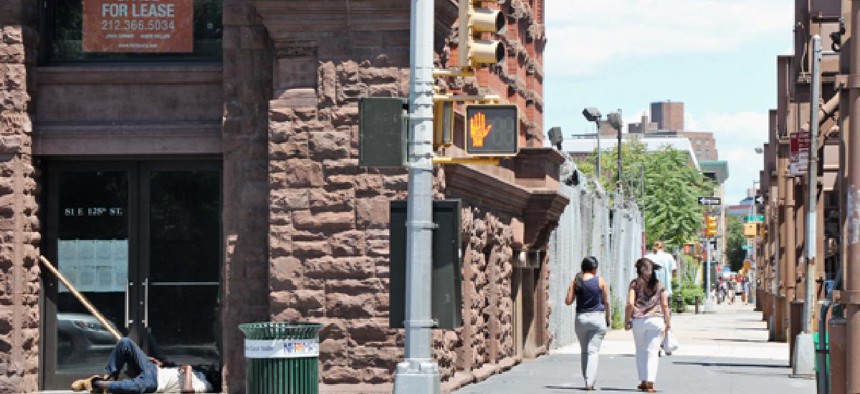Civil liberties and homeless advocates challenge NYPD over “move along” orders

Dan Rosenblum
It has been two months since the New York Civil Liberties Union and Picture the Homeless formally accused the NYPD of routinely ushering homeless New Yorkers from city streets, in violation of a 2013 law meant to prevent housing-based discrimination. But the advocates are still awaiting a response from police.
In a complaint to the city Human Rights Commission, detailed during a May press conference in Foley Square that was attended by roughly two dozen advocates and homeless people, the civil liberties group urged HRC to investigate police orders to disperse homeless people.
The organizations say police are violating the Community Safety Act, which the City Council passed three years ago over a veto by then-Mayor Bloomberg. The law forbids police from using housing status such as homelessness or being a public housing tenant when making law enforcement decisions.
The HRC has been occupied with moving its offices to another location in Lower Manhattan and didn’t serve the NYPD until June 28, giving it until Aug. 2 to respond, an NYCLU spokesman said earlier this month.
“Citywide, we're definitely hearing that the NYPD is still engaged in widespread illegal use of ‘move-along’ orders to homeless people who aren't breaking any laws,” a spokesman for Picture the Homeless told New York Nonprofit Media this week.
"Nothing has changed," James Doctor, the group's civil rights campaign leader, said in an email. "We still get these bogus 'move along' orders every day, officers telling us to go to Point A and then another officer coming to tell us to go to Point B. That's definitely true here in Harlem, but I'm also hearing it from friends all over the city. If anything, it's gotten worse. They don't like that we're fighting back."
The group is planning an upcoming action to highlight the delay.
“Falling on hard times and not having a home does not make somebody deserve less dignity, less respect, less fairness than other people,” Donna Lieberman, the executive director of the NYCLU, said at the time.
The complaint describes a “concerted effort” that began in June of 2015, when police in East Harlem began to tell homeless residents that they would be arrested, taken to psychiatric hospitals or have their belongings confiscated if they didn’t comply with “move along” orders, according to the complaint, which was addressed to the commission’s Deputy Commissioner for Law Enforcement.
“These ‘move along’ orders disrupt the daily lives of people who are simply trying to survive,” said NYCLU Senior Attorney Alexis Karteron. “Issuing these orders without legitimate justification constitutes bias-based policing and is simply illegal.”
Several of the incidents were centered near the Metro-North Railroad tracks at E. 125th Street and Park Avenue, a stretch where there has been tension between a sizable homeless population and police seeking to address complaints of drug use and other issues. Picture the Homeless, a group composed of many homeless residents, also has its offices nearby.
In July 2015, police who were ordering some people to move told advocates “that the mayor wants the area cleaned up," the groups said. A community affairs officer from the 25th Precinct later told Picture the Homeless staff that the policy “wasn't exactly an edict, but they won't be allowed to be there, doing what they've been doing."
Jazmin Berges, an organizer with the group who at one time was homeless for three years, said displaced New Yorkers were ushered from block to block and often were sleep deprived. “Honestly, the Police Department has been harassing people, even during the daytime,” she said. “And I’m not talking about nighttime hours, where you are not allowed to be in the park, I’m talking about daytime hours where you can occupy public space.”
In February, homeless advocates complained to the NYPD about police conduct, referring specifically to an incident last September in which several homeless residents’ belongings were thrown into a city garbage truck.
But organizers said May’s complaint was the first major one of its kind under the Community Safety Act. Though the law allows advocates to file a lawsuit, they instead opted to ask the Commission on Human Rights to investigate police procedure.
“We hope that they’ll be talking to members of Picture the Homeless, talking to people in the community who have seen this go on unabated for months and months, and tell the NYPD to knock it off and ask them to issue policies and other reforms that will stop their officers from telling people to move along for no reason,” Karteron said at the time.
She added the Commission could sue the NYPD, depending on the results of the investigation, though it was “hard to speculate” on what steps would be needed to ensure the NYPD complied with a potential order.
Brooklyn City Councilman Brad Lander, a sponsor of the bill, said he supported the advocates’ complaint. “It is against the law, and the strengthening of our bias-based profiling law in the Community Safety Act was designed to prevent people from discrimination and bias, including homeless New Yorkers,” he said.
City Hall and police officials said they have complied with the law. “The city respects the rights of our homeless New Yorkers and has put in place a new comprehensive plan to reduce homelessness,” Monica Klein, a mayor’s office spokeswoman, said when the complaint was filed.
“The NYPD's outreach services and interactions involving the homeless are carried out in a lawful and appropriate manner,” a Police Department representative said.
Note: This article has been updated to reflect a comment from Picture the Homeless.
